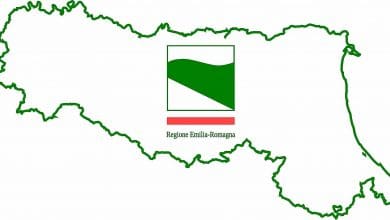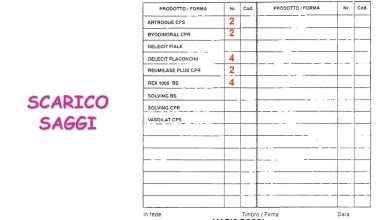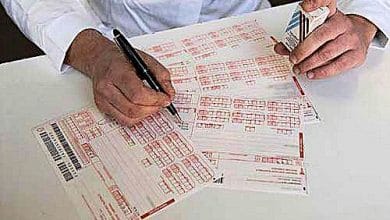
The origins
The origins of scientific information in ancient times are intertwined with the history of medicine and the history of drugs.
The birth of the first took place within the western "rationalistic" cultural climate of the fifth century BC 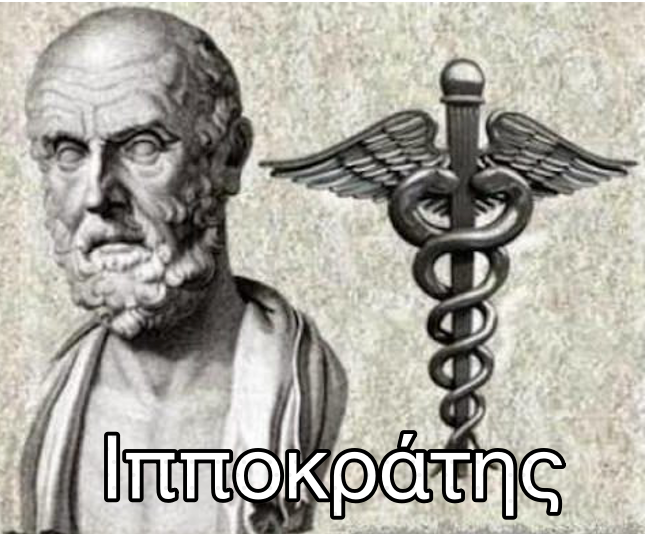 form of medical science: with Hippocrates of Kos, ancient Greek medicine emerged from the pre-scientific phase, linked to magical and religious practices and beliefs, and was organized around a decidedly rational, rigorous and empirical methodology.
form of medical science: with Hippocrates of Kos, ancient Greek medicine emerged from the pre-scientific phase, linked to magical and religious practices and beliefs, and was organized around a decidedly rational, rigorous and empirical methodology.
In ancient Greece the rhizotómoi (ῥιζοτόμοι: literally root cutters) researched and treated with herbs and roots, as well as in theancient Rome where the first real pharmacies were born (Tabernae medicoe) in which the figure of the "Pharmacotriba" no longer practiced medicine but sold medicinal remedies and created compound medicines prescribed by doctors. The medicinal roots studied and sold by the so-called "pharmacopolis" (-poly from πολύς "Very" that is, capable of preparing many medicines) were mainly based on notions taken from the texts of Hippocrates of Kos and on the botany writings of Theophrastus.
The medieval monasteries, expanding and spreading, organized their guests which obviously needed artisanal "pharmaceutical workshops" which equipped themselves with splendid botanical gardens. Adjacent to the apothecary were in fact the so-called gardens of the simple (medicamentum simplex). Since ancient times there has been a particular interest in all the plants used to compose medicines. These could differ in simple, if made with a single plant or compounds if obtained with the combination of several plants.
A legend has it that in the 9th century four characters met by chance in Salerno: the Christian Salernus, the Greek Pontus, the Jew Helenus and the Arab Adela, who pooled their knowledge and founded a school of medicine: the 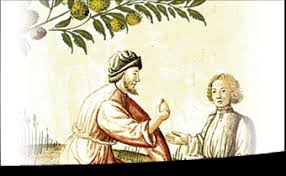 Salerno Medical School. In the Minerva Gardens in Salerno at the beginning of the 1300s, for the first time, a large quantity of plants and herbs were cultivated and classified, to study their therapeutic and medicinal properties for scientific purposes. Here was a real one scientific information activities (ostenium simplicium) on the properties of plants and herbs with their name and their characteristics and their therapeutic properties to the students of the Medical School.
Salerno Medical School. In the Minerva Gardens in Salerno at the beginning of the 1300s, for the first time, a large quantity of plants and herbs were cultivated and classified, to study their therapeutic and medicinal properties for scientific purposes. Here was a real one scientific information activities (ostenium simplicium) on the properties of plants and herbs with their name and their characteristics and their therapeutic properties to the students of the Medical School.
In Italy, the figure of the pharmacist (the apothecary or rhizotome), considered a whole in the medical profession until the 12th century, began to establish itself as an independent professional from the 13th century thanks above all to the will of Emperor Frederick II of Swabia. In fact, it was Frederick II in 1240 who with the "Costitutiones" separated and regulated the exercise of the medical profession and that of the apothecary, defining their relationships and forbidding them from any form of association (Scuola Medica Salernitana). Paragraph 46 of the Melfi Constitutions prescribes: “The doctor will not be able to practice the pharmacy or form a partnership with a trainer“
The apothecary in the Middle Ages was the one who dealt with the preparation of medicines, usually had a shop, defined apothecary, within which he also carried out the sale of spices and medicinal herbs.
Was Dante Alighieri a scientific informant?
In the communal era, apothecaries were grouped into guilds or guilds, the Guild of Physicians and Apothecaries is one of the 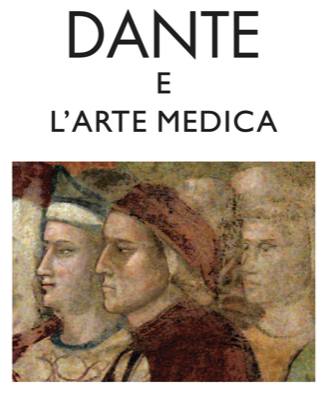 seven major guilds of the municipal age (14th century). Among its most illustrious members we can remember Dante Alighieri. The corporation had the task of checking that the activity was carried out by actually trained and competent apothecaries, a sort of ante litteram professional Order.
seven major guilds of the municipal age (14th century). Among its most illustrious members we can remember Dante Alighieri. The corporation had the task of checking that the activity was carried out by actually trained and competent apothecaries, a sort of ante litteram professional Order.
Common sense rules were established, respect for ethics, but also harsh financial penalties for those doctors and apothecaries who had not fulfilled their obligations, sincerely considered to be of public utility. It was therefore an obligation for the members of this Art to give advice when requested, not to cheat, to prepare the products conscientiously, it was it is forbidden to give percentages to the doctor in exchange for prescriptions and so on, as well as to undergo periodic or extraordinary checks by "searchers" placed under the orders of the Rectors. These checks, which initially concerned above all the commercial aspect and the correctness of the sales activity, went, mainly starting from the seventeenth century, to investigate the sanitary aspect (preparation, conservation, cleaning, etc).
Tommaso Garzoni recommended, at the very beginning of the sixteenth century, for the opening and management of an apothecary, a series of tools, such as vases, vases, mugs, boxes, scales, spatulas, mortars, presses. He also advised medicines by dividing them into simple or compound and internal; the latter were those that had to quell pain, and were used against deadly evils (the most common remedies were mithridate and theriaca, but purges of rose juice and licorice and radicchio syrups were used); the recommended external medicines were almond, juniper and walnut oils.
Fast forward two centuries to 1763 GB Capello he maintained that the primary actions of the apothecary were to pound, wash, infuse, cook, distill, compose compounds and store them, know grammar and medical science.
In the 19th century A. Campana warned that the apothecary had to know chemistry at all costs, otherwise he could only open a grocery store. Thus were born the first real schools of Pharmacy and it is in this period that the ancient name of apothecary begins to wane and that of pharmacist begins to establish itself (that is, the one who exercises the art of pharmacopoeia, or the preparation of drugs), but still in the twentieth century 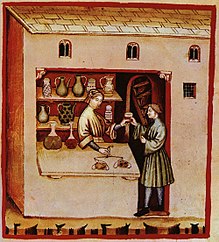 we find isolated figures of apothecaries, such as that of the famous Zambuten (a healer), in Forlì.
we find isolated figures of apothecaries, such as that of the famous Zambuten (a healer), in Forlì.
In the apothecary's shop there were also perfumes and essences, the colors used in painting and by dyers, wax and candles, paper and ink and often also spiced sweets prepared by the apothecary himself. The activity of the apothecary was, in medieval times, one of the most profitable.
Initially the title of charlatan was not disparaging, it indicated the wandering pharmacist-therapist who, having arrived in a new square, assembled the counter and shelves, made himself known by publicly praising his abilities.
The Charlatan
In usage, a subtle difference is made between the charlatan and people who otherwise exploit good faith 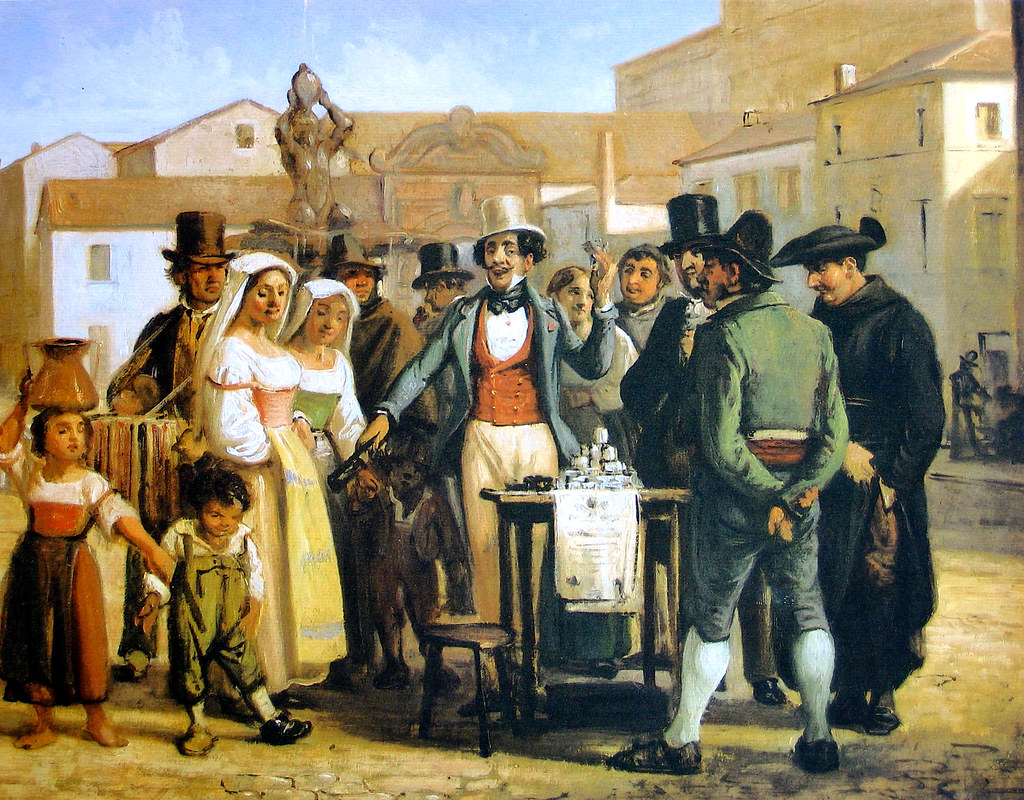 of their victims. Indeed, the charlatan is typically a salesman. He does not seek to create a personal relationship with his victims, or to stage elaborate hoaxes by playing a role.
of their victims. Indeed, the charlatan is typically a salesman. He does not seek to create a personal relationship with his victims, or to stage elaborate hoaxes by playing a role.
The development of the figure of the charlatan as an itinerant doctor in the square is also to be attributed to provisions which, between the 16th and 17th centuries, frame the competences of the various health professions such as «the physicist, the surgeon or surgeon, the apothecary or apothecary, the charlatan, the barber» ', a term that defines a person from Cerreto, a city in Umbria.
It took on a negative meaning when the person called a quack is accused of using pseudoscience or some other false means in order to deceive people and sell them fake medicines and similar goods or services, which will not perform as promised
It should not be confused with the Cerusico which is a term which for many centuries referred to the surgeon. The figure of the surgeon appears during the early Middle Ages, a time in which the surgical activity was relegated to the hands of minor figures: barbers, butchers, street vendors.
The industry
The pharmaceutical industry as we know it only began in the second half of the 19th century as a sector of the chemical industry. The Enlightenment revolution of the 17th century had spread rationalism and 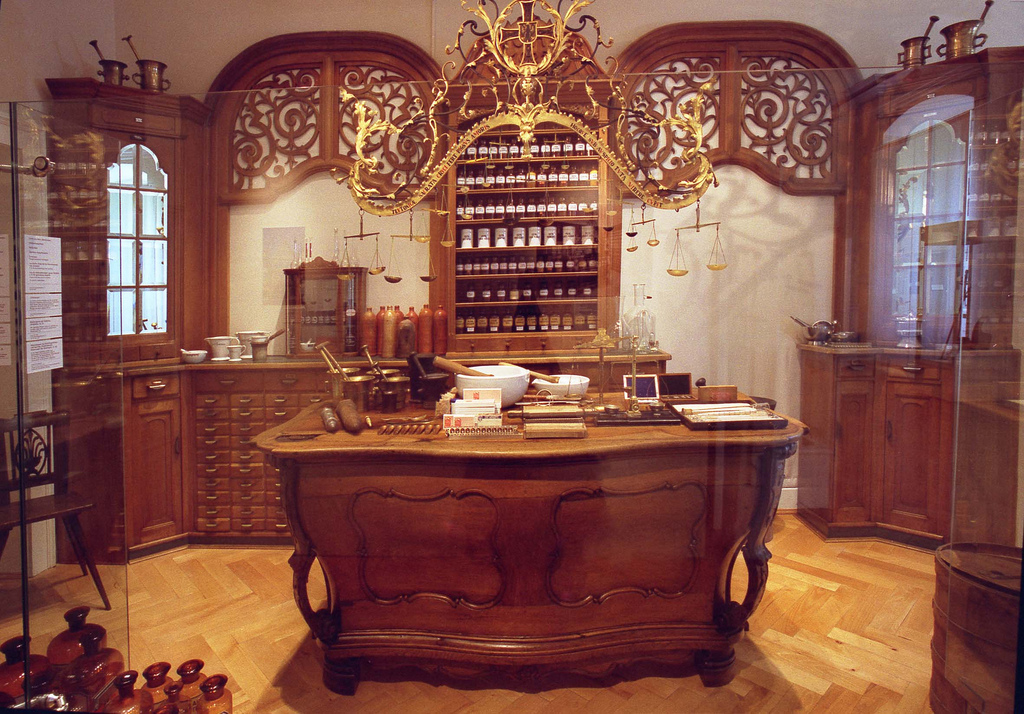 experimentation as methods of investigation.
experimentation as methods of investigation.
Merck in Germany was probably the first company to look in that direction. Originally a pharmacy (Engel Apotheke pictured left) founded in Darmstadt in 1668, in 1827 it was transformed by the hand of Heinrich Emanuel Merck, focusing on the manufacture and sale of alkaloids. Similarly GlaxoSmithKline had origins in 1715, but only in 1842 Beecham became interested in the industrial production of medicines, opening the first factory of only medicines in 1859. Bayer was founded by a dyer in 1863 in Wuppertal. On August 10, 1897, in the Bayer laboratories, the German chemist Felix Hoffmann obtained acetylsalicylic acid for the first time, a compound derived from the willow plant that would become universally known as Aspirin. Obviously, the commercialization of aspirin decreed its success at the beginning of the 20th century.
Meanwhile in the United States Pfizer was founded in 1849 by two German immigrants, cousins Charles Pfizer and Charles Erhardt, initially in the business of fine chemicals (unmixed chemicals). They rapidly expanded their business during the American Civil War as demand for antiseptics and painkillers soared. While Pfizer supplied the medicines needed for the Union war effort, a young cavalry colonel named Eli Lilly served in their army. Trained Pharmaceutical Chemist Lilly was the archetypal industrialist 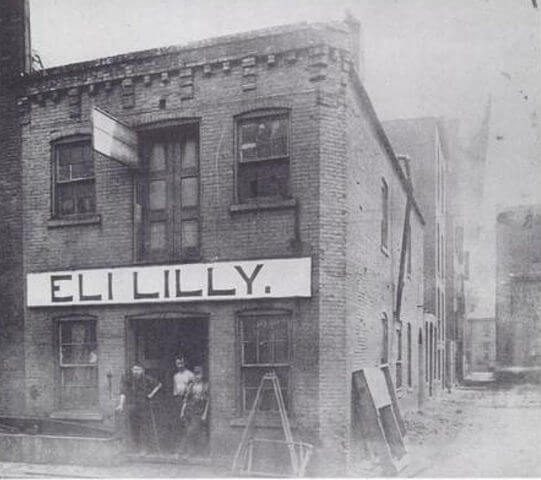 American in the 19th century and after his military career he opened his own pharmaceutical company in 1876. He was a pioneer of new methods for industry, becoming one of the first to devote himself to "research and development" as well as manufacturing.
American in the 19th century and after his military career he opened his own pharmaceutical company in 1876. He was a pioneer of new methods for industry, becoming one of the first to devote himself to "research and development" as well as manufacturing.
The first drug, in the modern sense of the term, was undoubtedly penicillin, the official discovery of which in 1928 is attributed to Fleming, although we know that he was a doctor of the Italian Navy, Vincent Tiberius, who was the first to formulate in 1895 the hypothesis that some molds released substances capable of inhibiting the development of bacteria and he had already started his studies which had led him to the discovery of first antibiotics.
With the pharmaceutical industry also came the need to make known their pharmaceutical products to prescribers in general and to doctors in particular. Thus was born the figure of the propagandist who went to hospitals and clinics to make medicines known on behalf of the industry he represented.
But as the industry grew with its growing portfolio of products, the potential ethical conflict of making money selling health-related products became increasingly clear. George Merck expressed himself on the subject in 1950: “We should never forget that medicine is for people. It's not for profits. Profits come as a result, and if we remember this lesson, they won't stop being there. The better we remember it, the greater the profits”. This industry involving the "public" required oversight, and drug regulations required by governments on both sides of the Atlantic increased.
The Scientific Representative of the drug
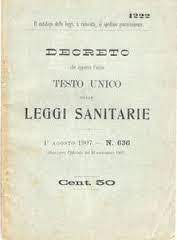 The figure of the Scientific Representative of the drug has found the first regulatory reference in Italian legislation in the Consolidated Text of Health Laws (Royal Decree July 27, 1934, n. 1265, published in the Official Gazette of August 9, 1934, n. 186).
The figure of the Scientific Representative of the drug has found the first regulatory reference in Italian legislation in the Consolidated Text of Health Laws (Royal Decree July 27, 1934, n. 1265, published in the Official Gazette of August 9, 1934, n. 186).
In Florence on October 25, 1964, the ANCSIF – National Association of Scientific Collaborators of the Pharmaceutical Industry – was born, which starting from November 18, 1979, will be called the Italian Association of Scientific Pharmaceutical Representatives (AIISF).
On April 9, 1965 theHon. De Maria (DC) presents in Parliament the first bill (proposal n.2256), which provides for the establishment of a register of scientific collaborators. The bill establishing a register of scientific informants will be present in all subsequent legislatures, including the current one.
On August 5, 1978 the law was promulgated Law n.484 which lays the foundations for a regulation on scientific information and the advertising of medicines which was then regulated in the subsequent regulation which took place with the law n.833 of 1978, which establishes the SSN, which in art. 29 says that a State law must be implemented “la regulation of the scientific information service on medicines and of the activity of scientific representatives”, according to criteria consistent with the objectives of the national health service, with the social function of the drug and with the prevailing public purpose of the production of the drugs themselves. In addition to the art. 31 states that "the national health service is responsible for providing scientific information on drugs and for monitoring the scientific information activity of the companies that hold authorizations to place drugs on the market". Several Ministerial Decrees followed which indicated the rules from
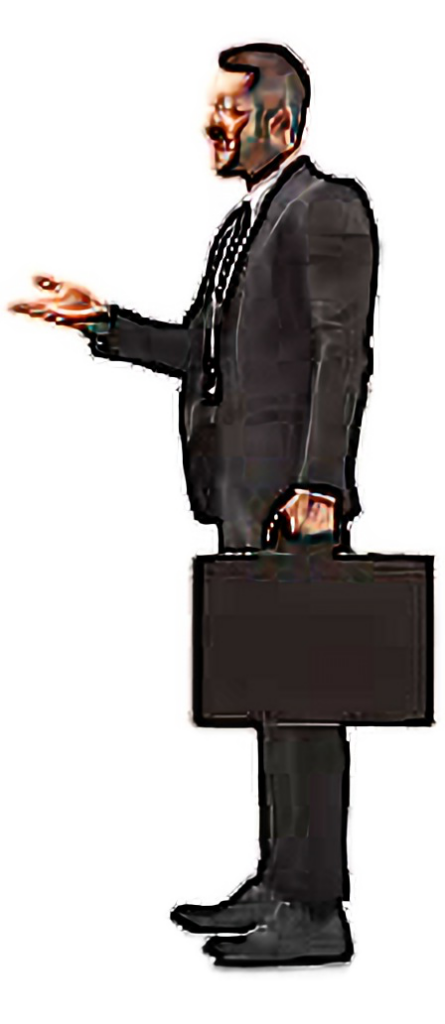 follow for scientific information.
follow for scientific information.
A few years later, the European Commission drafted a series of Directives which concerned the homogenization of the legal provisions on scientific information applied in the individual member countries of the Community (Directive no. 92/28 EEC, transposed in Italy with the Legislative Decree 30 December 1992, no. 541, outlined the professional figure of the ISF).
The university diploma in scientific information on drugs was established with the decree of the Minister of University and Scientific and Technological Research of 30 June 1993
This was followed by the Law 24.11.2003 N. 326, which in article 48.21 required the regions to provide, also with an administrative provision, to regulate the activity of scientific information. This is where they originate from regional regulation guidelines on scientific information, then adopted by almost all regions.
The university diploma becomes a full-fledged degree. Following the Decree 22 October 2004, n.270 many universities have activated the degree course in scientific information on drugs.
Coming to today, following the European Directives 2001/83/CE and 2003/94/CE, the Legislative Decree 24 April 2006, n. 219 that atarticle 122 (“Requirements and activities of scientific representatives”), reformulated the content of the activity of scientific representatives.
Today there is no more regulated profession than that of drug sales representatives.
Related news:
Pharmacotherapeutic principals over the centuries historical evolution
The drug, 7000 years of history
The Ancient Pharmacies: a journey to the edge of magic – The Renaissance
The Medical School of Salerno - The legend of the Foundation

